Solera Shouldn't Be a Dirty Word in Rum
My long-time readers know that few things get me more fired up than taking aim at the conventional wisdom about some aspect of rum. Not for sport but because conventional wisdom often lacks firm grounding in fact and/or understanding. Today, we’ll talk about why solera aging is a punching bag for many rum enthusiasts and why it doesn’t deserve this contempt. There’s still some shaming, but it’s not for solera aging.
In the interest of full disclosure, I’ve taken aim at solera aging in some of my early writing, the best-known example being a PUNCH article from 2017, Has “Solera” Become a Dirty Word in Rum? I stand by what I wrote in that article, but I have gained a far broader perspective of the rum world and its many varied traditions in the years since.
The solera aging method originated in Spain for aging wine, so it’s no surprise that rum makers in Spanish heritage countries are its most frequent practitioners. In brief, solera aging treats a set of casks as an integrated aging system rather than many individual casks, each doing their own thing.
A solera system has two or more groups of casks that we’ll call levels, e.g., level 1, level 2, level 3, etc… Rum enters the system at level 1. Periodically, a small amount of rum is removed from all casks of a particular level and moved to the next level. For instance, a bit of rum from each level 1 cask moves to level 2 casks. Likewise, some rum in the level 2 casks moves to level 3 casks, and so forth.
The implication is that anything entering the solera will eventually spend time at each level before finally exiting. It also means that every cask is a blend of rums of different ages. The final level of a solera, where the rum finally exits, may contain rums aged just a few years alongside rum aged for many decades.
The advantage of solera aging is that what emerges changes very little from year to year. Because everything that emerges from the solera is a mixture of rums distilled and aged at different times, any “oddball” distillations or casks have minimal impact on the “moving average.” If consistency over many years is the goal, solera aging is for you.
The downside to solera aging is that the concept of minimum age statements is essentially meaningless. While a solera-aged rum might have an average age of 25 years, a few drops of rum that raced through in 5 years means it’s only a 5-year-aged rum. If age statements are your foremost indicator of a rum’s quality, solera rums may not be for you. (More for the rest of us, though.)
There’s much more to solera aging, but a deep dive isn’t on today’s agenda. Should you need a deeper understanding, there are many online resources, as well as Chapter 8 (“Aging”) in Modern Caribbean Rum.
Zacapa, “23”, and Sistema Solera
Much of the hullabaloo over how solera aging is dishonest stems from one brand. Ron Zacapa is made in Guatemala by Industrias Licoreras de Guatemala (ILG). In 2011, Diageo, one of the world’s largest spirits conglomerates, purchased a 50% ownership stake in the Ron Zacapa brand. ILG also makes and owns the Botran brand. While the Zacapa and Botran brands have small differences, they are mostly made in the same way.
In recent years, Ron Zacapa has become one of the world’s best-known “luxury” rum brands largely because of Diageo’s substantial marketing clout and reach. Zacapa has been a “gateway rum” for many people, myself included. Zacapa is an approachable rum without any sharp, distinct or unusual flavors you might find in, say, Caroni, El Dorado, or Hampden Estate rums.
In what follows, I’m specifically describing the Zacapa brand’s core expression, No. 23 Centenario.
What most riles up certain enthusiasts isn’t that Zacapa is a “beginner rum” or that it’s on the sweeter side. Rather, it’s the prominent “23” on the label. A typical consumer glancing at the label might think it’s aged for at least 23 years. However, a closer examination of the label reveals that the 23 isn’t part of an age statement. Neither “years” nor “aged” appear on the label. The brand’s marketing notes that the Centenario is a blend of rum between 6 and 23 years old.
Nonetheless, the large 23 on the feels like a minimum age statement to some, and a 2021 lawsuit against Zacapa took issue with it. What comes from the lawsuit remains to be seen, but many enthusiasts have cheered it on to strike a blow against what they assert is deception by the brand.
Sistema Solera
Adjacent to the “23” on the Zacapa Centenario label is the phrase “sistema solera,” or in English, “solera system.” Zacapa has sometimes shared extensive details about their elaborate aging process, for which they deserve all due credit. However, sistema solera is notably different from traditional solera aging. (See the addendum at the end for the details.)
Nonetheless, I have no issue with how Zacapa and Botran rums are aged. But by associating “sistema solera” and “23” on the label, one can see why some people write off solera aging as misleading. To be fair, Zacapa is not alone here. The American brand Papa’s Pilar has an expression where “24” once appeared next to “Solera Profile” on the label. Another expression had a “7” next to “Solera Profile.” The brand has since stopped using those numbers on its labels. Nonetheless, in both cases—Zacapa and Papa’s Pilar— there have been numbers that look like age statements appearing near “solera” but which aren’t actual age claims.
Unfortunately, countless liquor retailers are clueless about this subtlety and unhesitatingly state that Zacapa’s Centenario is aged 23 years and that Papa’s Pilar is aged 24 years. Between brands running right up to the line of truth and retailers (unintentionally) crossing over it, it gives rum transparency advocates a big target, with solera aging caught in the crossfire.
Solera Through a Different Lens
Having covered why some enthusiasts take aim at solera aging, let’s look at some rums that use solera aging and have nothing to take issue with. The common denominator with most of these rums is twofold:
No age statement is stated nor implied by the brand
Solera is only part of the overall aging process
Santa Teresa 1796 - Venezuela
All rums in Santa Teresa’s flagship 1796 expression undergo both traditional and solera aging. The three types of rum, light continuous, heavy continuous, and heavy batch, first age for at least four years in ex-bourbon barrels.
After this initial aging, all three types of rum are blended and then placed into Santa Teresa’s solera. Over five hundred Limousin oak casks in four levels comprise the solera, which has operated since 1992. The solera’s final level has rum aged up to thirty-five years. But since the 1796 expression has no age statement, there’s nothing to take issue with.
Santa Teresa has an exceptionally well-made video showing all aspects of how 1796 is made: Santa Teresa 1796, Solera method
Varela Hermanos (Ron Abuelo) - Panama
Similar to Santa Teresa 1796, some higher-end Abuelo expressions like Centuria undergo solera aging after first aging for 12 years in ex-bourbon barrels. Varela Hermanos’ solera has been in place since 1978, and the brand says the final solera level has a weighted average age of thirty years. The Centuria label contains nothing resembling a minimum age statement.
Destilería Serrallés (Don Q) – Puerto Rico
Tucked away in a Destilería Serrallés aging warehouse are around 130 ex-oloroso sherry casks arranged horizontally within several wooden frames. This three-level solera contains Serrallés’ longest-aged rum. The input to the solera is heavy column rum which previously aged at least four years in ex-bourbon barrels. Rum in the middle level has an average age of twenty years. Because the solera started in 1966, the bottom level contains rum aged up to 60 years.
From first-hand experience, I can say that this rum is very intense and tannic yet still rich with rummy flavors. The blenders at Serrallés use it in small amounts in various blends, much like a dash of bitters in a cocktail. Among the expressions utilizing this solera-aged rum is Don Q Gran Añejo, which doesn’t make or imply any age statement.
Williams & Humbert (Dos Maderas) - Spain
Dos Maderas 5+5 was one of my early gateways to the rum world, and I occasionally pour a dram to take me back to those less complicated days. While the Dos Maderas lineup has expanded recently, its two core expressions remain the 5+3 and 5+5.
The 5+3 expression uses a blend of rums from Guyana and Barbados that age for five years in the Caribbean. This rum then enters a two-level solera populated with Palo Cortado casks. After three years in this solera, it’s ready to be bottled. The 5+3 refers to five years of Caribbean aging and three years in the solera.
Dos Maderas’ 5+5 expression utilizes a separate two-level solera filled with Pedro Ximénez casks. This solera’s input is the aforementioned 5+3 rum, which ages two more years in the solera’s PX casks. The 5+5’s name also refers to the time spent Caribbean aging followed by solera aging.
You can learn more about Dos Maderas’ process, including the Luxus expression, from my Williams & Humbert writeup: Dos Maderas: Behind the Scenes at the Bodega.
Bayou Reserve - Louisiana
Louisiana’s largest rum distillery makes pot-distilled rums from locally sourced molasses. Of note here is the Bayou Reserve expression that’s fully solera aged for approximately four years. Reiniel Vicente, Bayou’s master blender and production manager, previously worked at Oliver y Oliver, a Dominican Republic brand that uses solera. Bayou’s solera started in 2016, almost certainly due to Reiniel’s experience. The Bayou Reserve label contains nothing that can be construed as an age claim.
Black Tot Solera – UK
Our last solera-using example is a recent release from the UK — Black Tot Historic Solera. The rum starts with the brand’s Finest Caribbean blend, which then spends two years in 500-liter sherry casks; some PX, others oloroso. Those two sherry-influenced rums then enter a solera housed at Scotland’s Tormore distillery. The solera is composed of 46 800-liter oloroso casks in three levels. As with all Black Tot expressions, no age statement is given or implied.
Average Age Statements
Since we’ve been considering age statements in the context of blends of rums of different ages, let’s briefly consider what an “average age” statement means. Some of you are recoiling in horror at the mere thought, but bear with me for a moment.
Most countries require that age statements can only refer to the youngest component in the spirit. However, a few rum-producing countries— Guatemala, Costa Rica, and Panama- allow average age statements. Yes, minimum age statements aren’t a worldwide standard.
The typical argument against average age statements goes like this:
“If you blend a drop of 18-year aged rum with a cask of 2-year aged rum, you shouldn’t be able to say that average age is 10 years.” (The average of 18 and 2 is 10.)
I agree, but this simplistic application of “average” isn’t how the countries above calculate the average age. Instead, they use a weighted average, which considers how much of each component is in the blend and removes water from the calculation. Using the above “18 + 2” scenario, the weighted average age is some minuscule amount over 2 years. In other words, it is a reasonably accurate representation of the rum.
While you still may be dubious about weighted average age statements, here’s food for thought. Look at the component rums in this Black Tot release. Under minimum-aging rules, it can only claim 2 years of aging. However, a clear majority of the blend has aged significantly longer. Is 2 years really a reasonable representation of the rum’s aging?
If you’re curious how weighted average age calculations work, check out this story, Minimum Age Statements – Can We Do Better?
Conclusion
Like many enthusiasts, I’m strongly against shenanigans in rum. But in the rush to cast stones at some brand’s legitimacy, it’s easy to embrace overly simplistic views. Solera aging is one example.
Solera is a widely accepted way to age wine and spirits. And while most of the world’s rum ages entirely within one cask, solera aging is a good example of how rum isn’t lockstep and monolithic like certain spirits. Solera aging’s value shouldn’t be diminished because of how certain brands label their product.
Yes, certain rum brands use misdirection. Also, the sun rises in the east. However, the drinker who thinks critically and doesn’t blindly follow “rules of thumb” about solera from the internet will find many good solera-aged offerings.
Addendum - Zacapa’s Sistema Solera
What follows was in an early draft of this article, which I removed for flow. I’m leaving it here for those curious about how Zacapa’s solera system works.
Here is a short summary of how Zacapa’s aging differs from typical solera aging. Zacapa Centenario’s Sistema solera process uses four stages, with each stage using a different cask type:
American oak casks that previously aged American whiskey
Charred American oak barrels that previously aged American whiskey
Casks that previously aged Oloroso sherry
Casks that previously aged Pedro Ximénez sherry.
Before a batch of rum progresses to the next stage, all casks in the current stage are completely emptied, and the contents are blended. This differs from the usual solera process wherein casks are only partially emptied, and all casks contain rums of many different ages.
Elsewhere are vats of “mother rum” that have fully completed the aging process. When the inter-stage blending vats are filled, a portion of the mother rum is included. In the diagram below, this mother rum is called “older lots.” (Yes, this graphic shows Botran rum, but the process for Zacapa is similar.)
Zacapa says the first six years of aging are in ex-American whiskey casks. If the brand desired to put a minimum age statement on the label, it could accurately say it is a six-year-aged rum. However, that doesn’t sound as luxe as “a blend of rums between 6 and 23 years.”



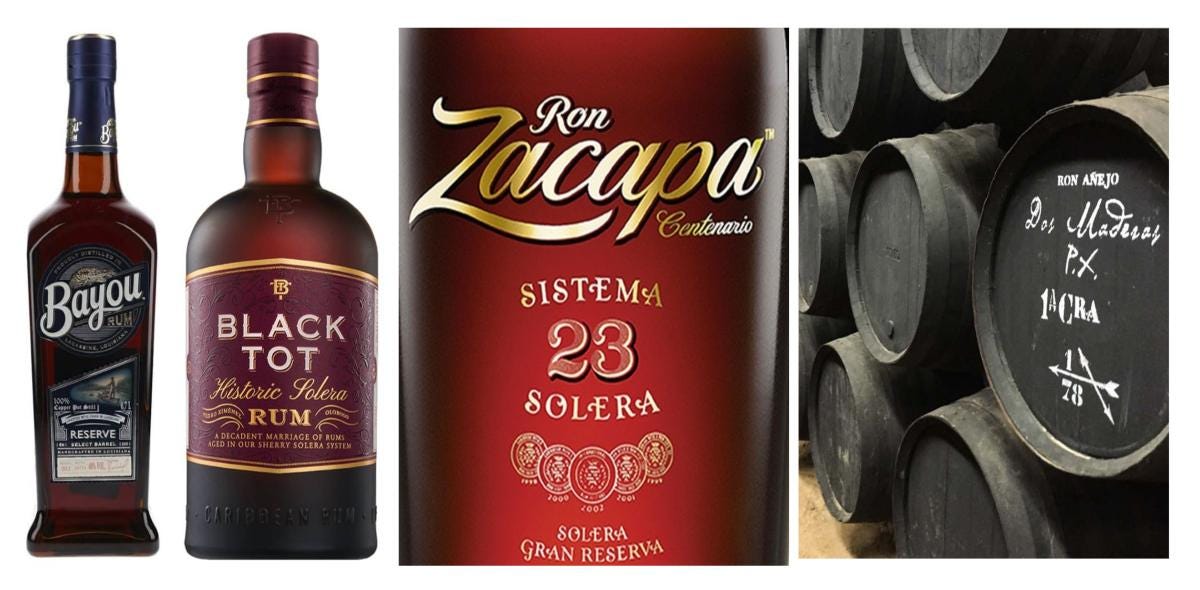
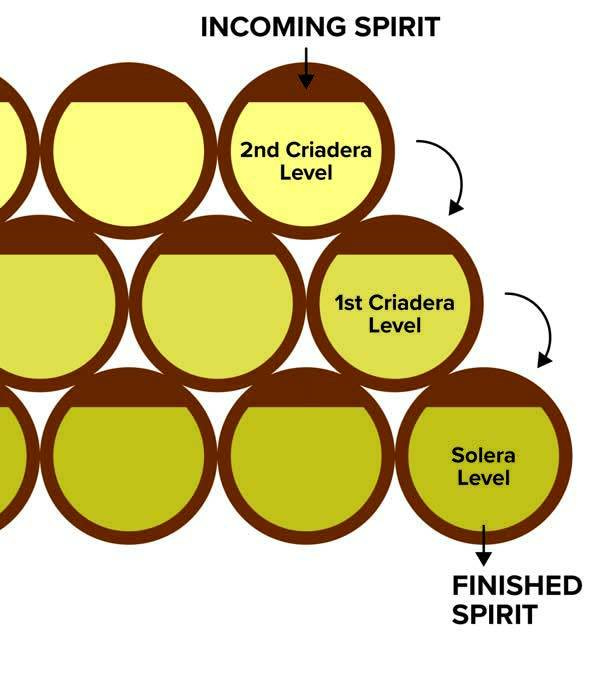
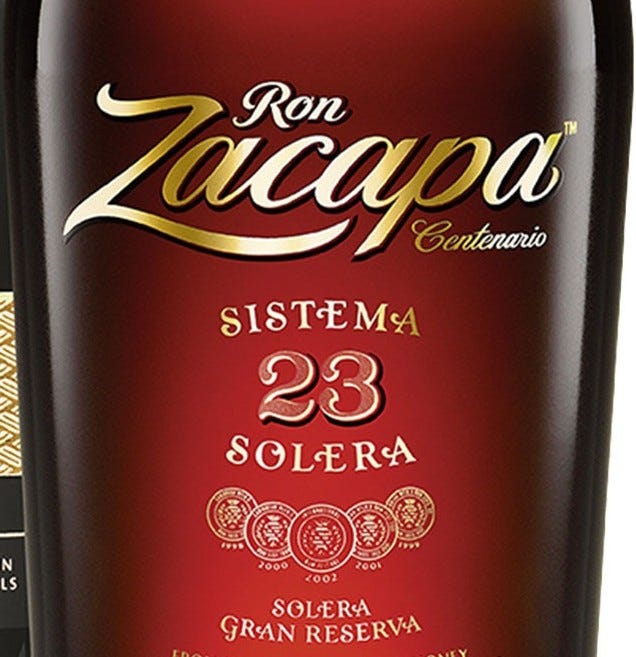

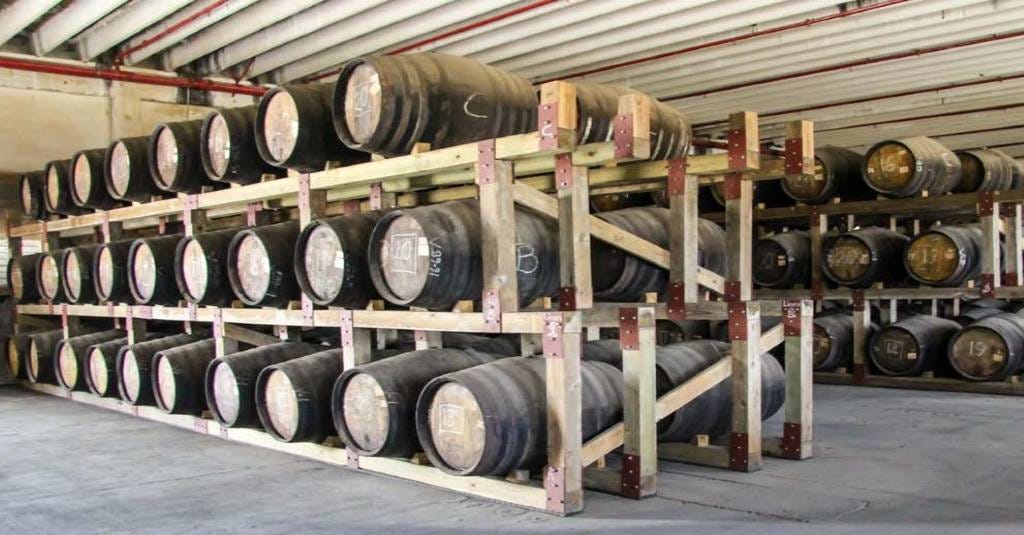
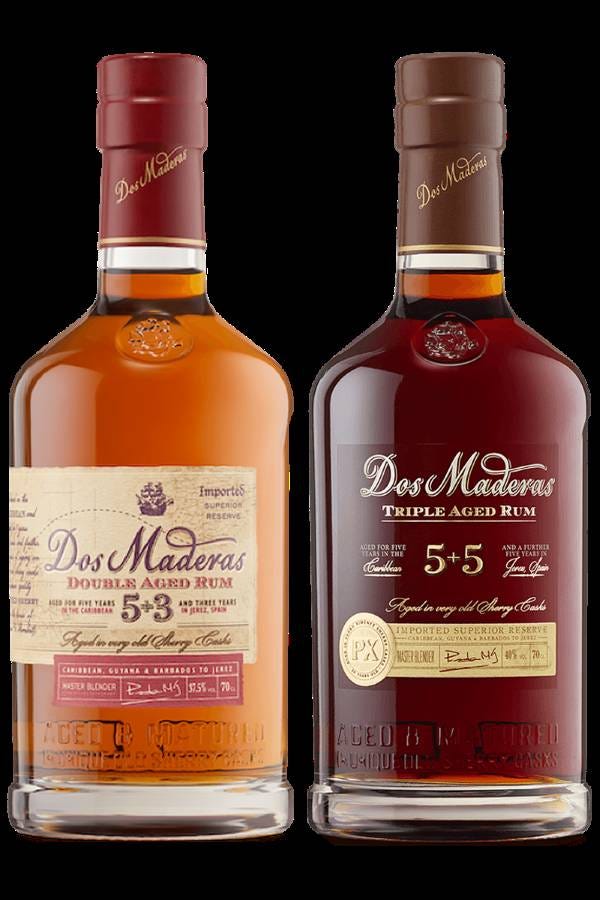


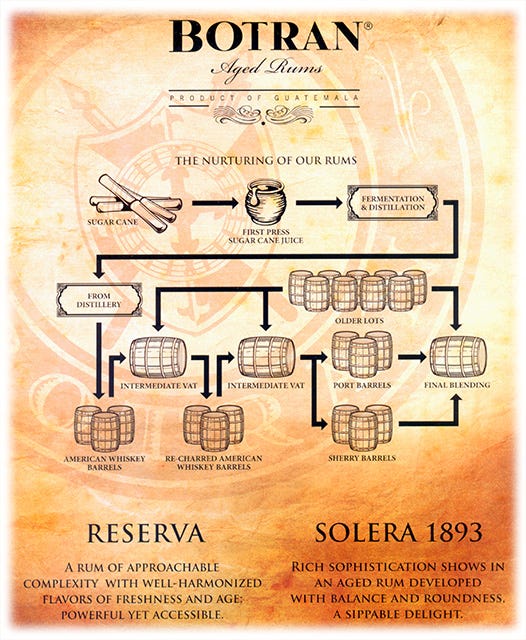

The Solera system, in the rum industry, is often presented as a sophisticated way to categorize blended rum, but in reality, it’s more of a marketing tool than a transformative process. The Solera method truly shines in the production of fortified wines, where it makes complete sense for this type of beverage.
In the sherry industry, the Solera system involves blending older and younger wines to create a consistent and complex product. The older wine, known as the madre (mother), imparts its characteristics to the younger wine, which may contain various microorganisms that contribute to the development of unique flavours and aromas. This process is somewhat akin to maintaining a sourdough starter. However, this system doesn’t translate well to rum production due to the significantly higher alcohol content (around 65% ABV in rum compared to 20% in sherry). The high alcohol level in rum kills off the bacteria and microorganisms that play a crucial role in flavour development in sherry. As a result, the chemical interactions that make the Solera system effective in sherry simply don’t occur in rum.
Another important point about Solera and the use of sherry casks in the spirits industry is that the casks are often not what they seem. The sherry casks used for aging rum or whiskey are typically sherry-infused casks. These casks are made from white American oak and are infused with young, low-quality sherry for about 18 months before being sold to the spirits industry. The sherry used for this infusion is not the high-quality drinking sherry but rather a young wine that is often repurposed into vinegar or distilled after use.
If you’re interested in learning more about this topic, I discussed it in detail with Nicolas Kroeger, the owner of Wagemut Rum, in a recent podcast episode. Check it out for deeper insights: https://theglobalglug.com/a-deep-dive-into-rum-solera-aging-sherry-casks-and-sugar-insights-from-nicolas-kroger-of-wagemut-rum/
This system is just a warehouse space saver. Barrels should not have an empty space. And then they declared it something exceptional.